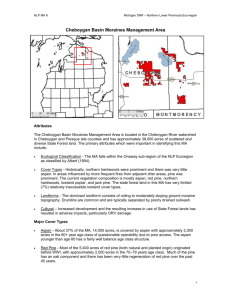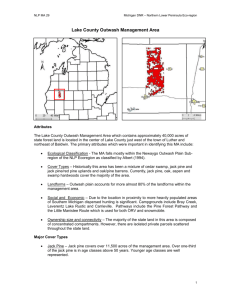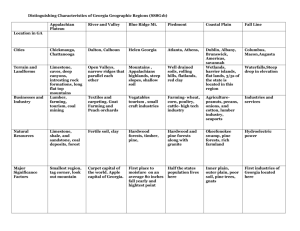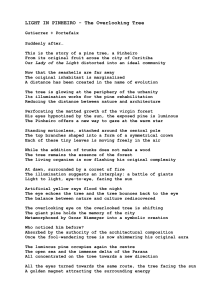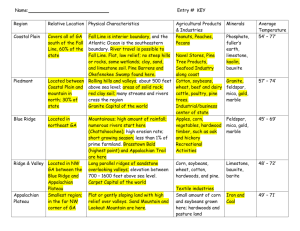Cheboygan Lake Plain MA Brief
advertisement
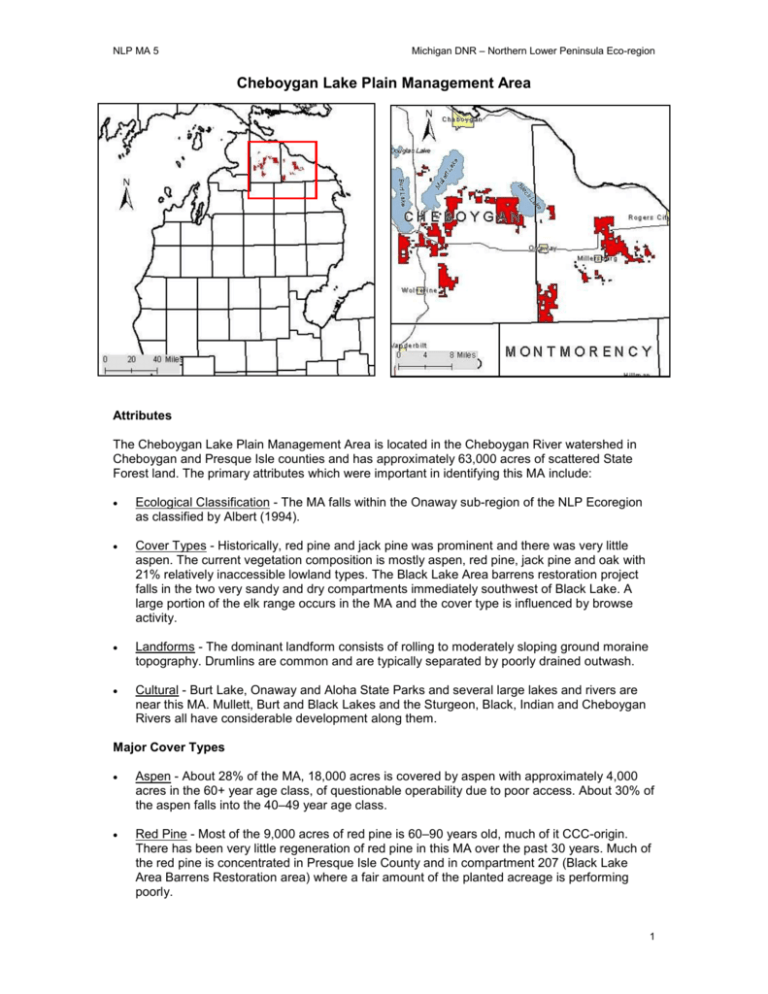
NLP MA 5 Michigan DNR – Northern Lower Peninsula Eco-region Cheboygan Lake Plain Management Area Attributes The Cheboygan Lake Plain Management Area is located in the Cheboygan River watershed in Cheboygan and Presque Isle counties and has approximately 63,000 acres of scattered State Forest land. The primary attributes which were important in identifying this MA include: Ecological Classification - The MA falls within the Onaway sub-region of the NLP Ecoregion as classified by Albert (1994). Cover Types - Historically, red pine and jack pine was prominent and there was very little aspen. The current vegetation composition is mostly aspen, red pine, jack pine and oak with 21% relatively inaccessible lowland types. The Black Lake Area barrens restoration project falls in the two very sandy and dry compartments immediately southwest of Black Lake. A large portion of the elk range occurs in the MA and the cover type is influenced by browse activity. Landforms - The dominant landform consists of rolling to moderately sloping ground moraine topography. Drumlins are common and are typically separated by poorly drained outwash. Cultural - Burt Lake, Onaway and Aloha State Parks and several large lakes and rivers are near this MA. Mullett, Burt and Black Lakes and the Sturgeon, Black, Indian and Cheboygan Rivers all have considerable development along them. Major Cover Types Aspen - About 28% of the MA, 18,000 acres is covered by aspen with approximately 4,000 acres in the 60+ year age class, of questionable operability due to poor access. About 30% of the aspen falls into the 40–49 year age class. Red Pine - Most of the 9,000 acres of red pine is 60–90 years old, much of it CCC-origin. There has been very little regeneration of red pine in this MA over the past 30 years. Much of the red pine is concentrated in Presque Isle County and in compartment 207 (Black Lake Area Barrens Restoration area) where a fair amount of the planted acreage is performing poorly. 1 Michigan DNR – Northern Lower Peninsula Eco-region NLP MA 5 Jack Pine – About 3,500 acres of the almost 9,000 acres are over age 60. The 10–30 age class totals 3,200 acres reflecting active and relatively recent harvesting and regeneration. Oak – The oak is quite old, 76% of it is over 80 years of age. Natural white pine regeneration is occurring on some oak sites. Mixed Swamp Conifers and Cedar – Mixed swamp conifer and cedar accounts for approximately 7,300 acres, most of it in older age classes and considered inoperable due to poor access. Cheboygan Lake Plain Cover Type Aspen Age Class (Years) Acres % 0-9 10-19 20-29 30-39 40-49 50-59 60-69 70-79 80-89 90-99 Uneven Aged 100+ 17,691 28% 1,531 2,992 2,360 5,319 1,285 542 1,185 1,672 626 4 2 173 Red Pine 8,980 14% 0 176 141 297 905 1,690 2,268 2,355 345 333 292 178 Jack Pine 8,841 14% 1,313 1,908 568 802 590 371 985 1,511 516 85 0 192 Oak 5,453 9% 99 317 93 54 27 2 433 1,553 1,601 1,005 155 110 Mixed Swamp Conifers 4,321 7% 0 1 31 17 59 306 470 1,196 1,000 665 429 147 Cedar 3,016 5% 0 0 0 0 0 99 257 198 690 864 894 14 Lowland Poplar 2,769 4% 182 407 616 213 89 24 146 586 369 90 0 47 Upland Hardwoods 1,630 3% 0 50 0 17 0 0 189 164 83 22 0 1,105 Swamp Hardwoods 1,383 2% 0 30 1 6 25 27 742 125 59 0 368 0 Lowland Brush 3,030 5% Grass 1,376 2% Upland Brush 375 1% Water 297 0% 3,595 6% Other Types Total 62,757 Other Types include: Marsh, White Pine, Bog, Spruce-Fir, White Birch, Upland Mixed Conifers, Black Spruce, Hemlock, Upland Mixed Deciduous, and Tamarack. Concepts of Management Aspen (28% of the MA) – Focus management on balancing the distribution of the 0-59 year age classes, by targeting the 40–49 year age class. If accessible, harvest aspen older than age 70. Allow inaccessible aspen in the 60+ year classes to succeed to more shade tolerant species such as red maple and white pine. Red Pine (14% of the MA) – Follow the Red Pine Management Guidelines to balance the age class distribution. Allow selected areas of managed red pine to reach biological maturity. Allow poor site-index sites to convert to more suitable jack pine resulting in an overall reduction in red pine acreage. Jack Pine (14% of the MA) – Balance the age class distribution in the 0-69 year age classes targeting natural stands in the 70-79 age class. It is expected that jack pine acreage will increase due to conversions from red pine. Oak (9% of the MA) –Improve age class distribution and promote/re-introduce pine seed sources resulting in communities that have a mixture of oak, red pine and jack pine and other species. Mixed Swamp Conifers and Cedar (12% of the MA) – Regeneration harvests should be considered if deer browsing can be minimized and wetland soils are not adversely impacted. 2
